医院感染是全球范围内一项严重的公共卫生问题,可引起额外的并发症,增加患者病死率和治疗费用。多种途径可预防医院感染的发生,如环境消毒与管理、隔离防护、抗菌药物合理使用、患者定期筛查、手卫生等,其中,医务人员手卫生被认为是最简单、有效、经济的降低医院感染发病率的措施[1-2]。医务人员在工作中接触患者及其体液、物品等,容易成为医院感染的传播源,而正确的手卫生行为可减少医务人员手上的病原菌数量,降低感染风险[3-4]。然而,手卫生依从率低一直是有待改进的问题之一[5-6]。因此,上海市某三甲医院通过多模式手卫生干预提高医务人员手卫生依从性,回顾性观察其对手卫生依从率的影响,并分析手卫生依从率与医院感染例次发病率之间的关系。
1 资料与方法 1.1 研究设计2014年1月—2022年12月,上海某三甲医院感染控制团队对该院所有病房的医务人员实施多模式干预措施,医院感染管理办公室每周抽查医务人员手卫生依从性,每月监测住院科室的手卫生用品消耗量,分析期间的手卫生监测数据及手卫生依从率与医院感染例次发病率之间的关系。
1.2 多模式手卫生干预措施 1.2.1 手卫生培训医院感染办公室定期开展医务人员手卫生培训,培训内容包括:手卫生的重要性、手卫生的指征与操作要求、手卫生的设备要求、手卫生的监测效果评价等。
1.2.2 完善手卫生设施根据场所要求采用非接触式水龙头或长柄龙头,配备皂液、一次性擦手纸、手卫生流程图,在各科室及公共区域增加速干手消毒剂摆放点位,如走廊、病房门口、电梯内、自助机旁等。
1.2.3 提高医务人员手卫生责任意识各科室张贴手卫生宣传画,包括洗手池、病房走道、治疗室、生物样本运送专用盒等;为每台工作电脑设置手卫生提示屏保;在每年的感染控制周系列活动中强调手卫生的重要性,丰富内容和形式,如手卫生讲座、知识问答、手卫生荧光自测、洗手技能操作等。
1.2.4 分析与反馈医院感染管理办公室每半年以医院感染简讯的形式在OA及医院感染监测平台公布全院手卫生监测情况;如发现问题,提出解决方案,督促责任科室和个人落实整改。
1.3 监测方法 1.3.1 手卫生用品消耗量2015年1月起,通过医院感染监测软件监测普通病房及重症监护病房(ICU)的手卫生用品消耗量,每月进行数据分析。手卫生用品每床每日消耗量(mL/床·日)=部门确定时段手卫生用品消耗总量/该部门同期住院患者床日数。
1.3.2 手卫生依从性医院感染办公室专职人员采用直接观察法每周抽查医务人员手卫生依从性,选择具有代表性的观察区域和时间段,在不告知研究对象的情况下,收集世界卫生组织(WHO)提出的5个手卫生时刻(接触患者前、无菌操作前、接触体液后、接触患者后和接触患者周围环境后) 的手卫生数据。手卫生依从率=手卫生执行时机数/应执行手卫生时机数×100%。
1.3.3 医院感染研究中的医院感染病例是在医院获得感染的住院患者,采用医院感染监测软件对医院感染发生情况进行跟踪,该软件与医院所有电子数据库相连,医院感染管理办公室专职人员根据《医院感染监测标准》[7]定期监测,与临床医生核实后确诊。发生在全院及普通病房的医院感染采用医院感染例次发病率进行数据分析,发生在ICU的医院感染采用医院感染日例次发病率进行数据分析。医院感染例次发病率=指定时间段内住院患者中新发医院感染例次数/同期住院患者总数×100%。医院感染日例次发病率=指定时间段内新发医院感染例次数/同期住院患者住院总日数×1 000‰。
1.4 统计分析采用趋势卡方检验手卫生依从率趋势;采用线性回归分析医院感染例次发病率趋势;采用相关性分析手卫生依从率与医院感染例次发病率的相关性,线性关系采用Pearson相关分析,非线性关系采用Spearman相关分析。应用SPSS 26软件进行统计学分析,应用Graphpad Prism 9.5绘图。P≤0.05为差异具有统计学意义。
2 结果 2.1 手卫生用品消耗量2015年1月—2022年12月,普通病房与ICU的手卫生用品消耗量波动较小,仅ICU皂液消耗量在2022年有明显下降。见图 1。
 |
| 图 1 2015—2022年手卫生用品每床日数消耗量 Figure 1 Consumption of hand hygiene products per bed-day, 2015-2022 |
2014年1月—2022年12月,全院手卫生依从率从2014年64.98%提高到2022年85.01%,普通病房及ICU医务人员手卫生依从率呈上升趋势;全院医院感染例次发病率从1.21%下降至0.83%,普通病房医院感染例次发病率及ICU医院感染日例次发病率均呈下降趋势(均P<0.05),见表 1。各季度不同区域的手卫生依从率呈上升趋势(P<0.001),见图 2。各季度不同区域的医院感染例次发病率均呈下降趋势(均P<0.01),见图 3。各季度5个手卫生时刻的手卫生依从率中,无菌操作前与接触患者后的手卫生依从率小幅波动;接触患者周围环境后的手卫生依从率呈上升趋势;接触患者前与接触体液后的手卫生依从率在2020年后有所下降(均P<0.001),见图 4。在不同岗位类别的医务人员中,医生与护士的手卫生依从率均呈上升趋势,辅助人员的手卫生依从率有明显上升(均P<0.001),见图 5。
| 表 1 2014—2022年医务人员手卫生依从率与医院感染例次发病率 Table 1 Hand hygiene compliance rate and healthcare-associated case infection incidence, 2014-2022 |
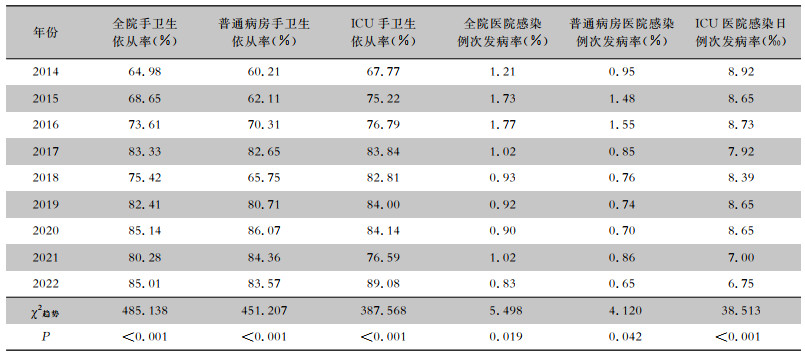
|
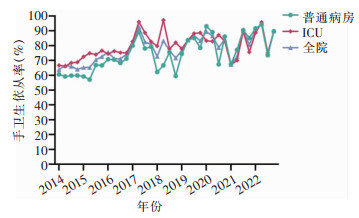 |
| 图 2 2014—2022年各季度不同区域医务人员手卫生依从率变化趋势 Figure 2 Changing trend of HCWs' hand hygiene compliance rates in different areas in each quarter, 2014-2022 |
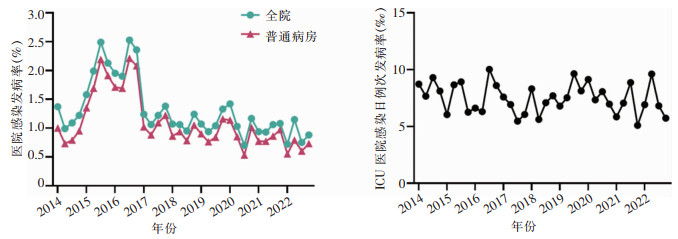 |
| 图 3 2014—2022年各季度全院与普通病房医院感染例次发病率及ICU医院感染日例次发病率及变化趋势 Figure 3 Incidence and changing trend of infection cases of the whole hospital and general wards as well as daily incidence and changing trend of infection cases in ICU in each quarter, 2014-2022 |
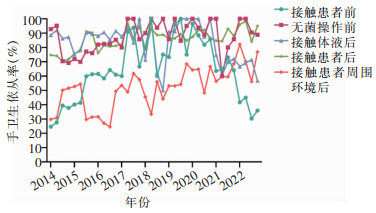 |
| 图 4 2014—2022年各季度5个手卫生时刻医务人员手卫生依从率及变化趋势 Figure 4 Compliance rates and changing trend of HCWs' hand hygiene at 5 hand hygiene moments in each quarter, 2014-2022 |
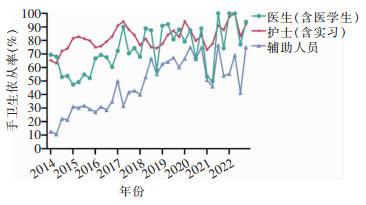 |
| 图 5 2014—2022年各季度不同岗位医务人员手卫生依从率及变化趋势 Figure 5 Compliance rates and changing trend of hand hygiene of HCWs in different job positions in each quarter, 2014-2022 |
各季度全院手卫生依从率与医院感染例次发病率之间存在负相关(r=-0.369;P=0.027),见图 6。普通病房手卫生依从率与其医院感染例次发病率无相关性(r=-0.255;P=0.134),ICU医务人员手卫生依从率与患者医院感染日例次发病率无相关性(r=-0.076;P=0.660)。
 |
| 图 6 全院各季度医务人员手卫生依从率与医院感染例次发病率的相关性 Figure 6 Correlation between HCWs' hand hygiene comp-liance rate and the incidence of HAI cases in the whole hospital in each quarter |
医务人员手卫生是预防医院感染的重要措施之一,相关研究[8-11]表明,多模式手卫生干预有利于提高医务人员的接受程度和手卫生依从性。该院实施多模式手卫生干预[12],每年分批分层次对全院医务人员进行手卫生培训,2015年起积极响应国家行动计划,强化培训力度,采用线上、线下及实操等多种授课形式,并针对手卫生意识较差的辅助人员进行专项培训。2020年国家卫生健康委员会颁布新版《医疗机构医务人员手卫生规范》(WS/T 313—2019)[13],医院感染管理办公室及时更新制度,组织临床科室学习。新型冠状病毒感染疫情暴发后,进一步加强医院感染防控培训力度,确保手卫生人人知晓、人人落实、人人过关。同时,在后勤及临床各科室的大力支持下,手卫生设施得以全面覆盖,并能确保手消毒剂的充足和有效性,方便医务人员进行手卫生操作并养成习惯。此外,日常手卫生宣教及感染控制周丰富的主题活动强化了医务人员的手卫生意识。
本研究结果显示,通过多模式手卫生干预,手卫生用品消耗量呈稳定上升趋势,且均达到上海市医院感染质量控制要求(病房每床日使用免洗手消毒凝胶>5 mL,抗菌洗手液>10 mL,监护室每床日使用免洗手消毒凝胶>10 mL,抗菌洗手液>20 mL)。全院手卫生依从率持续上升,且与全院医院感染发病率呈负相关,与之前相关研究[8, 14-15]结果基本一致;ICU、普通病房的手卫生依从率与其医院感染例次发病率无相关性,考虑原因为其科室分类众多,床位规模大,收治患者病情多样,特别是ICU住院患者基础疾病重,感染因素复杂,因此手卫生依从率与医院感染例次发病率之间无相关性。不同岗位类别间比较,护士手卫生依从率最高,与之前的相关研究[16-18]结果基本一致,辅助人员手卫生依从率较低,考虑存在群体文化水平较低、流动性大等原因,故需定期对辅助人员开展手卫生培训。不同区域间比较,ICU医务人员手卫生依从率高于普通病房医务人员手卫生依从率,说明ICU医务人员的手卫生依从性更高。不同时刻手卫生依从率显示,接触体液后的手卫生依从率2020年之后有所下降,考虑原因为2021、2022年的调查样本中辅助人员占比较往年高(往年占比10%~20%,2021年占比40%,2022年占比63.64%),导致结果波动较大。接触患者前的手卫生依从率2020年后有所下降,考虑原因为:(1)部分医务人员用佩戴手套代替手卫生;(2)2022年的调查样本中辅助人员占比高于往年(往年占比<10%,2022年占比38.24%),因此,应在以后的调查中注意样本岗位类别分布的均衡性;(3)2020年初新型冠状病毒感染暴发促使医务人员手卫生意识显著提高[19-22],但2020年后部分医务人员手卫生意识有所松懈。此外,调查中发现手套代替手卫生的现象主要发生于接触患者前、无菌操作前及接触体液后;接触患者前的手卫生依从性较低,部分医务人员对此时刻的手卫生意识薄弱,应着重针对以上两个方面进行改进。
综上所述,多模式手卫生干预能提高医务人员的手卫生依从性,有利于降低医院感染例次发病率。本研究是回顾性研究,未进行严格的设计,存在一定的局限,如手卫生依从性观察仅采用直接观察法,可能与实际情况有偏差。后续应完善研究设计,采取更客观的评价方法(如隐蔽式观察法),引入电子监测设备,整合信息化手段等,降低霍桑效应对结果的影响[23-24],以期为该研究领域提供科学的参考依据。
利益冲突:所有作者均声明不存在利益冲突。
| [1] |
Magill SS, O'Leary E, Janelle SJ, et al. Changes in prevalence of health care-associated infections in U.S. hospitals[J]. N Engl J Med, 2018, 379(18): 1732-1744. DOI:10.1056/NEJMoa1801550 |
| [2] |
Liu YH, Xiao W, Wang SH, et al. Evaluating the direct economic burden of health care-associated infections among patients with colorectal cancer surgery in China[J]. Am J Infect Control, 2018, 46(1): 34-38. DOI:10.1016/j.ajic.2017.08.003 |
| [3] |
Vermeil T, Peters A, Kilpatrick C, et al. Hand hygiene in hospitals: anatomy of a revolution[J]. J Hosp Infect, 2019, 101(4): 383-392. DOI:10.1016/j.jhin.2018.09.003 |
| [4] |
Lotfinejad N, Peters A, Tartari E, et al. Hand hygiene in health care: 20 years of ongoing advances and perspectives[J]. Lancet Infect Dis, 2021, 21(8): e209-e221. DOI:10.1016/S1473-3099(21)00383-2 |
| [5] |
李慧, 赵萍, 刘鑫, 等. 基于系统评价的三级公立医院医护人员手卫生依从性状况调查[J]. 中国消毒学杂志, 2022, 39(1): 65-68. Li H, Zhao P, Liu X, et al. Investigation on hand hygiene compliance status of medical staff in tertiary public hospitals based on systematic evaluation[J]. Chinese Journal of Disinfection, 2022, 39(1): 65-68. |
| [6] |
文细毛, 黄勋, 曾烂漫, 等. 2019年全国医疗机构医务人员诊疗过程手卫生监测报告[J]. 中国感染控制杂志, 2021, 20(5): 389-396. Wen XM, Huang X, Zeng LM, et al. Hand hygiene surveillance report of health care workers during diagnosis and treatment in medical institutions in China in 2019[J]. Chinese Journal of Infection Control, 2021, 20(5): 389-396. |
| [7] |
国家卫生健康委. 医院感染监测标准WS/T 312—2023[J]. 中国感染控制杂志, 2023, 22(9): 1129-1142. Standard for healthcare associated infection surveillance WS/T 312-2023[J]. Chinese Journal of Infection Control, 2023, 22(9): 1129-1142. |
| [8] |
Han CY, Song Q, Meng X, et al. Effects of a 4-year intervention on hand hygiene compliance and incidence of healthcare associated infections: a longitudinal study[J]. Infection, 2021, 49(5): 977-981. DOI:10.1007/s15010-021-01626-5 |
| [9] |
刘安云, 沈茹. 医务人员手卫生依从性现状及管理策略进展[J]. 中国消毒学杂志, 2019, 36(1): 63-65. Liu AY, Shen R. Status quo and management strategy progress of hand hygiene compliance among health care workers[J]. Chinese Journal of Disinfection, 2019, 36(1): 63-65. |
| [10] |
游先容, 许航, 黄小明. 医护人员手卫生认知、依从性及影响因素分析[J]. 中国消毒学杂志, 2019, 36(8): 598-601, 605. You XR, Xu H, Huang XM. Cognition, compliance and influencing factors of hand hygiene among medical staffs[J]. Chinese Journal of Disinfection, 2019, 36(8): 598-601, 605. |
| [11] |
刘卫平, 焦月英, 郭天慧, 等. 医务人员医院感染防控知信行及影响因素调查[J]. 中华医院感染学杂志, 2019, 29(12): 1906-1910, 1916. Liu WP, Jiao YY, Guo TH, et al. Nosocomial infection prevention and control knowledge, attitude and practice and influencing factor survey among healthcare workers[J]. Chinese Journal of Nosocomiology, 2019, 29(12): 1906-1910, 1916. |
| [12] |
陆峰, 傅小芳, 沈瑞红, 等. 提高手卫生依从性对医院感染现患率的影响[J]. 中华医院感染学杂志, 2010, 20(23): 3709-3710. Lu F, Fu XF, Shen RH, et al. Effects of hand hygiene compliance on prevalence rate of nosocomial infection[J]. Chinese Journal of Nosocomiology, 2010, 20(23): 3709-3710. |
| [13] |
中华人民共和国国家卫生健康委员会. 医务人员手卫生规范: WS/T 313—2019[S]. 北京: 中国标准出版社, 2019. National Health Commission of the People's Republic of China. Specification of hand hygiene for healthcare workers: WS/T 313-2019[S]. Beijing: Standards Press of China, 2019. |
| [14] |
Grayson ML, Stewardson AJ, Russo PL, et al. Effects of the Australian national hand hygiene initiative after 8 years on infection control practices, health-care worker education, and clinical outcomes: a longitudinal study[J]. Lancet Infect Dis, 2018, 18(11): 1269-1277. DOI:10.1016/S1473-3099(18)30491-2 |
| [15] |
Ojanperä H, Kanste OI, Syrjala H. Hand-hygiene compliance by hospital staff and incidence of health-care-associated infections, Finland[J]. Bull World Health Organ, 2020, 98(7): 475-483. DOI:10.2471/BLT.19.247494 |
| [16] |
刘思娣, 黄勋, 李春辉, 等. 2016—2020年某三级甲等医院医务人员手卫生依从性调查[J]. 中华医院感染学杂志, 2020, 30(24): 3823-3827. Liu SD, Huang X, Li CH, et al. Survey of the compliance with hand hygiene in a tertiary hospital from 2016 to 2020[J]. Chinese Journal of Nosocomiology, 2020, 30(24): 3823-3827. |
| [17] |
徐丹慧, 刘晓, 陈夏容, 等. 北京市8所综合性医院手卫生隐蔽式调查分析[J]. 中国感染控制杂志, 2018, 17(10): 872-877. Xu DH, Liu X, Chen XR, et al. Concealed investigation on hand hygiene in 8 general hospitals in Beijing[J]. Chinese Journal of Infection Control, 2018, 17(10): 872-877. |
| [18] |
吴晓春, 曲秀娟, 陈苑利. 某三级综合教学医院手卫生暗访调查现状及对策研究[J]. 中国感染控制杂志, 2018, 17(11): 1019-1021, 1025. Wu XC, Qu XJ, Chen YL. Concealed investigation on status and countermeasures of hand hygiene of health care workers in a tertiary comprehensive teaching hospital[J]. Chinese Journal of Infection Control, 2018, 17(11): 1019-1021, 1025. DOI:10.3969/j.issn.1671-9638.2018.11.015 |
| [19] |
杨志芳, 杨诏旭, 孙惠英, 等. 新冠病毒感染疫情对某医院医疗工作人员手卫生依从性影响调查[J]. 中国消毒学杂志, 2023, 40(3): 204-207. Yang ZF, Yang ZX, Sun HY, et al. Influence of COVID-19 on hand hygiene compliance of medical staff in a hospital[J]. Chinese Journal of Disinfection, 2023, 40(3): 204-207. |
| [20] |
赵婷婷, 赵晗晹, 王洁, 等. 新冠肺炎疫情前后某三甲医院手卫生依从性调查分析[J]. 中国消毒学杂志, 2021, 38(8): 589-591. Zhao TT, Zhao HY, Wang J, et al. Investigation and analysis on hand hygiene compliance rate among health care workers at a tertiary care hospital before and after the COVID-19 epidemic[J]. Chinese Journal of Disinfection, 2021, 38(8): 589-591. |
| [21] |
Wang Y, Yang JR, Qiao F, et al. Compared hand hygiene compliance among healthcare providers before and after the COVID-19 pandemic: a rapid review and Meta-analysis[J]. Am J Infect Control, 2022, 50(5): 563-571. DOI:10.1016/j.ajic.2021.11.030 |
| [22] |
Stangerup M, Hansen MB, Hansen R, et al. Hand hygiene compliance of healthcare workers before and during the COVID-19 pandemic: a long-term follow-up study[J]. Am J Infect Control, 2021, 49(9): 1118-1122. DOI:10.1016/j.ajic.2021.06.014 |
| [23] |
贾会学, 赵艳春, 贾建侠, 等. 医务人员手卫生依从性评价方法的探讨[J]. 中国感染控制杂志, 2019, 18(9): 819-823. Jia HX, Zhao YC, Jia JX, et al. Evaluation methods of hand hygiene compliance of health care workers[J]. Chinese Journal of Infection Control, 2019, 18(9): 819-823. |
| [24] |
Diefenbacher S, Plotzki C, Schneider-Brachert W, et al. Differences in observed and self-reported compliance with' five moments for hand hygiene' as a function of the empathy of healthcare workers[J]. J Hosp Infect, 2022, 128: 39-46. DOI:10.1016/j.jhin.2022.07.008 |



